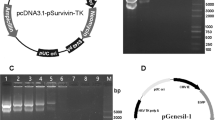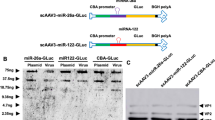Abstract
Cancer-targeting gene-viro-therapy is a promising cancer therapeutic strategy that strengthens the antitumor effect of oncolytic viruses by expressing an inserted foreign antitumor gene. To achieve liver cancer targeting and to improve the safety of the ZD55 vector (a widely-used E1B55KD gene-deleted oncolytic adenoviral vector (OV), we previously constructed), we designed a novel OV named Ad·AFP·D55 that selectively replicates in hepatocellular carcinoma (HCC) cells by replacing the E1A promoter with the liver-cancer specific α-Fetoprotein (AFP) promoter based on the ZD55 vector. We found that the oncolytic adenoviruses Ad·AFP·D55-IL-24 and Ad·AFP·D55-TRAIL express tumor-suppressor gene interleukin-24 (IL-24) and tumor necrosis factor-related apoptosis-inducing ligand (TRAIL), respectively, significantly suppressed the HCC cell growth in vitro by inducing apoptosis by the caspase-8 and mitochondria-dependent caspase-9 signaling pathways. Furthermore, the combined treatment of Ad·AFP·D55-IL-24 and Ad·AFP·D55-TRAIL showed strong antitumor effects in vivo by significantly inhibiting the tumor growth in HCC HuH-7 cell xenograft mice, and markedly increasing animal survival rate. Therefore, this novel HCC cell-targeting OV carrying tumor-suppressor genes may provide a promising approach for liver cancer gene therapy.
This is a preview of subscription content, access via your institution
Access options
Subscribe to this journal
Receive 12 print issues and online access
$259.00 per year
only $21.58 per issue
Buy this article
- Purchase on Springer Link
- Instant access to full article PDF
Prices may be subject to local taxes which are calculated during checkout






Similar content being viewed by others
References
Liu XY . A new anticancer strategy —gene-viroTherapy Therapy of cancer. Chinese J Cancer Biother 2001; 8: 1.
Pei Z, Chu L, Zou W, Zhang Z, Qiu S, Qi R et al. An oncolytic adenoviral vector of Smac increases antitumor activity of TRAIL against HCC in human cells and in mice. Hepatology 2004; 39: 1371–1381.
Zhao L, Dong A, Gu J, Liu Z, Zhang Y, Zhang W et al. The antitumor activity of TRAIL and IL-24 with replicating oncolytic adenovirus in colorectal cancer. Cancer Gene Ther 2006; 13: 1011–1022.
Zhang Y, Gu J, Zhao L, He L, Qian W, Wang J et al. Complete elimination of colorectal tumor xenograft by combined manganese superoxide dismutase with tumor necrosis factor-related apoptosis-inducing ligand gene virotherapy. Cancer Res 2006; 66: 4291–4298.
Liu XY, Qiu SB, Zou WG, Pei ZF, Gu JF, Luo CX et al. Effective gene-virotherapy for complete eradication of tumor mediated by the combination of hTRAIL (TNFSF10) and plasminogen k5. Mol Ther 2005; 11: 531–541.
Fisher PB . Is mda-7/IL-24 a ‘magic bullet’ for cancer? Cancer Res 2005; 65: 10128–10138.
Wiley SR, Schooley K, Smolak PJ, Din WS, Huang CP, Nicholl JK et al. Identification and characterization of a new member of the TNF family that induces apoptosis. Immunity 1995; 3: 673–682.
Kagawa S, He C, Gu J, Koch P, Rha SJ, Roth JA et al. Antitumor activity and bystander effects of the tumor necrosis factor-related apoptosis-inducing ligand (TRAIL) gene. Cancer Res 2001; 61: 3330–3338.
Shi J, Zheng D, Liu Y, Sham MH, Tam P, Farzaneh F et al. Overexpression of soluble TRAIL induces apoptosis in human lung adenocarcinoma and inhibits growth of tumor xenografts in nude mice. Cancer Res 2005; 65: 1687–1692.
Cao X, Yang M, Wei RC, Zeng Y, Gu JF, Huang WD et al. Cancer targeting gene-viro-therapy of liver carcinoma by dual-regulated oncolytic adenovirus armed with TRAIL gene. Gene Therapy 2011; 18: 765–777.
Zhang ZL, Zou WG, Luo CX, Li BH, Wang JH, Sun LY et al. An armed oncolytic adenovirus system, ZD55-gene, demonstrating potent antitumoral efficacy. Cell Res 2003; 13: 481–489.
Bischoff JR, Kirn DH, Williams A, Heise C, Horn S, Muna M et al. An adenovirus mutant that replicates selectively in p53-deficient human tumor cells. Science 1996; 274: 373–376.
Wei N, Fan JK, Gu JF, He LF, Tang WH, Cao X et al. A double-regulated oncolytic adenovirus with improved safety for adenocarcinoma therapy. Biochem Biophys Res Commun 2009; 388: 234–239.
Camper SA, Tilghman SM . The activation and silencing of gene transcription in the liver. Biotechnology 1991; 16: 81–87.
Nakabayashi H, Hashimoto T, Miyao Y, Tjong KK, Chan J, Tamaoki T . A position-dependent silencer plays a major role in repressing alpha-fetoprotein expression in human hepatoma. Mol Cell Biol 1991; 11: 5885–5893.
Herrmann M, Lorenz HM, Voll R, Grunke M, Woith W, Kalden JR . A rapid and simple method for the isolation of apoptotic DNA fragments. Nucleic Acids Res 1994; 22: 5506–5507.
Takahashi M, Sato T, Sagawa T, Lu Y, Sato Y, Iyama S et al. E1B-55K-deleted adenovirus expressing E1A-13S by AFP-enhancer/promoter is capable of highly specific replication in AFP-producing hepatocellular carcinoma and eradication of established tumor. Mol Ther 2002; 5: 627–634.
Kim J, Lee B, Kim JS, Yun CO, Kim JH, Lee YJ et al. Antitumoral effects of recombinant adenovirus YKL-1001, conditionally replicating in alpha-fetoprotein-producing human liver cancer cells. Cancer Lett 2002; 180: 23–32.
Zhang J, Gan Y, Gu J, Hu J, Liu X, Zhao X . Potent anti-hepatoma efficacy of HCCS1 via dual tumor-targeting gene-virotherapy strategy. Oncol Rep 2008; 20: 1035–1040.
Liu XR, Cai Y, Cao X, Wei RC, Li HL, Zhou XM et al. A new oncolytic adenoviral vector carrying dual tumor suppressor genes shows potent antitumor effect. J Cell Mol Med 2011 (in press).
Saeki T, Mhashilkar A, Swanson X, Zou-Yang XH, Sieger K, Kawabe S et al. Inhibition of human lung cancer growth following adenovirus-mediated mda-7 gene expression in vivo. Oncogene 2002; 21: 4558–4566.
Soria C, Estermann FE, Espantman KC, O’Shea CC . Heterochromatin silencing of p53 target genes by a small viral protein. Nature 2010; 466: 1076–1081.
Cui Q, Jiang W, Wang Y, Lv C, Luo J, Zhang W et al. Transfer of suppressor of cytokine signaling 3 by an oncolytic adenovirus induces potential antitumor activities in hepatocellular carcinoma. Hepatology 2008; 47: 105–112.
Acknowledgements
We wish to thank Ying Xu, Lanying Sun, Jingfa Gu, and Cell Analysis Center (Institute of Biochemistry and Cell Biology, Shanghai Institutes for Biological Sciences, Chinese Academy of Sciences) for the professional technical assistance, and Mitchell Sullivan (University of Queensland) for proof-reading the article. This work was supported by the National Basic Research Program of China (973 Program) (No. 2010CB529901), Important National Science & Technology Specific Project of Hepatitis and Hepatoma Related Program (2008ZX10002-023), New Innovation Program (2009-ZX-09102-246), the Natural Science Foundation of China (Nos. 30801445, 81172971 & 30970607) and the Zhejiang Sci-Tech University grant (1016834-Y).
Author information
Authors and Affiliations
Corresponding authors
Ethics declarations
Competing interests
The authors declare no conflict of interest.
Rights and permissions
About this article
Cite this article
Liu, X., Cao, X., Wei, R. et al. Gene-viro-therapy targeting liver cancer by a dual-regulated oncolytic adenoviral vector harboring IL-24 and TRAIL. Cancer Gene Ther 19, 49–57 (2012). https://doi.org/10.1038/cgt.2011.67
Received:
Revised:
Accepted:
Published:
Issue Date:
DOI: https://doi.org/10.1038/cgt.2011.67
Keywords
This article is cited by
-
Recent advances of engineered oncolytic viruses-based combination therapy for liver cancer
Journal of Translational Medicine (2024)
-
Immunopathobiology and therapeutic targets related to cytokines in liver diseases
Cellular & Molecular Immunology (2021)
-
Oncolytic adenovirus programmed by synthetic gene circuit for cancer immunotherapy
Nature Communications (2019)
-
Reducing protein regulator of cytokinesis 1 as a prospective therapy for hepatocellular carcinoma
Cell Death & Disease (2018)
-
Combined therapy with oncolytic adenoviruses encoding TRAIL and IL-12 genes markedly suppressed human hepatocellular carcinoma both in vitro and in an orthotopic transplanted mouse model
Journal of Experimental & Clinical Cancer Research (2016)



